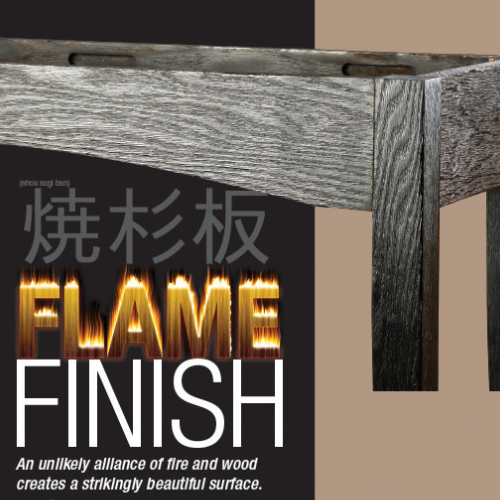Introducing: Flame Finish (Shou Sugi Ban)
The Japanese call it shou sugi ban. It translates to “burned cypress plank,” and is a traditional approach to treating home siding in Japan. Charring the surface of the wood creates a beautiful black finish that protects not only against rot, but also insects, who evidently hate the taste. It may seem counterintuitive, but this shallow, quick burning of the wood makes it fire resistant as well.
I’ve found that shou sugi ban is a great, tactile finish for interior work as well, and that it imparts a truly striking color and texture to a two-tone furniture piece like the table on page 36. Although cedar and pine are the traditional materials of choice for outdoor woods, I find that open grained, ring porous hardwoods like oak and ash lend a more refined look in their textures. Shou sugi ban is not a difficult skill to learn, very little equipment is required, and the style is currently very hot.
Safety Alert
To be absolutely fire-safe, you could burn outside on a concrete slab. However, I prefer to work inside in an area cleaned of sawdust, shavings, and wood scraps. If you can, begin the process with the piece upside down, targeting the raised section of the inverted piece, as I did with these table legs. For small pieces and panels, raise the work on cinderblocks. Of course you’ll want to keep water and a fire extinguisher at hand just in case. Finally, don’t work tired or mentally impaired; you need to stay alert when playing with fire!

Good cooking candidates. Oak and ash look great charred, brushed, and finished, regardless of the cut of the wood.
The right wood makes all the difference
I consider red oak the perfect candidate for this finish, although white oak and ash also take very nicely to it. The striking appearance is as much about texture as color. The coarse, open grain and clear delineation between latewood and earlywood in these species make the treatment really pop. The “cut” of the wood makes a difference too, as seen in the photo.
Before charring, sand the work through 180 grit. It may seem ridiculous to spend time sanding something that you’ll put a flame to, but charring doesn’t remove machine marks, and they don’t look good burned or not.

Tools and equipment
For the burning, I use a portable propane tank from the hardware store. It’s inexpensive and provides plenty of fuel for the job. I outfit it with an adapter on an extension hose to allow better maneuverability and flame control. For cleanup, choose a brush with stiff plastic bristles, which will remove soot without scarring the wood. To touch-up offset areas or recesses that are hard to burn properly, you can employ black aniline dye or a fine-tip black marker.
Clean and safe. When using flame in the shop, work in a clean, uncluttered area, and keep water and a fire extinguisher at hand just in case. With a table like this, invert it and burn the upended sections of the legs before righting it to finish the rest.
Burning creates the color
With the work at the ready, adjust your torch for a strong flame. Then, working in short, overlapping passes, play the flame over the surface. The trick to achieving a consistently flat, black char is to target small areas at a time, moving along as soon as the surface catches fire, after which the flames should immediately die out. If you’re getting anywhere near the point of needing to douse the project, work on fine-tuning your firebug sensibilities. Linger only as long as necessary, and avoid holding the flame too close to the work.
Go slowly over the piece, working one section or component in turn, paying attention to the flash point frequency as you move. You’ll find that quartersawn grain burns much more evenly and easily than flatsawn surfaces, so adjust your pace to suit. It can be difficult to get a solid black burn at the juncture of offset joints or other recesses without overcooking the wood, so leave them for touch-up later with dye or a marker. Scrutinize completed surfaces and revisit any areas that haven’t been fully blackened.

Brushing brings out the texture
The next step is brushing, which cleans away the majority of the soot while creating texture. This is due to the fact that early growth burns away more readily than the late growth. Brushing also helps to more evenly distribute the color. It’s not a complicated process, and it goes pretty quickly; just scrub vigorously in the direction of the grain.

Finishing includes a bit of touch-up
Now’s the time to touch up around any offset joints or other recesses that you couldn’t burn properly. You may be able to reach into these areas with a fine-tip marker, but applying dye with an artist’s brush is a better bet. I used to dye the entire piece after burning, in order to fill in any insufficiently charred areas. However, I’ve found that it’s kind of cool to see a bit of the oak color peeking through when lit with warm sunlight. It creates a bit of subtle warmth that the dye would remove.
Next, I suggest wiping the whole piece with boiled linseed oil. (Be sure to properly dispose of your oily rags, or you may have another type of fire to deal with.) After allowing the oil to cure for 5 days, I top-coat the piece with 3 or 4 coats of a satin wipe-on polyurethane, rubbing out with 0000 steel wool between coats.

Article by: Robert Spiece



Comments
Add comment